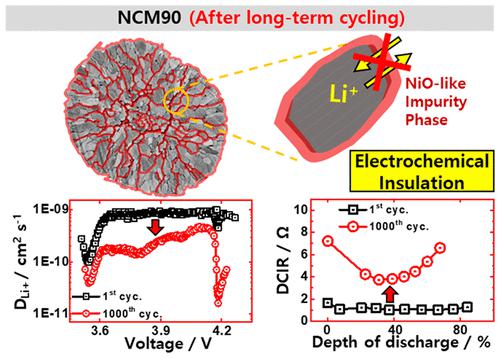当前位置:
X-MOL 学术
›
ACS Energy Lett.
›
论文详情
Our official English website, www.x-mol.net, welcomes your feedback! (Note: you will need to create a separate account there.)
Degradation Mechanism of Ni-Rich Cathode Materials: Focusing on Particle Interior
ACS Energy Letters ( IF 22.0 ) Pub Date : 2022-06-23 , DOI: 10.1021/acsenergylett.2c01272 Nam-Yung Park 1 , Geon-Tae Park 1 , Su-Bin Kim 1 , Wangmo Jung 2 , Byung-Chun Park 2 , Yang-Kook Sun 1
ACS Energy Letters ( IF 22.0 ) Pub Date : 2022-06-23 , DOI: 10.1021/acsenergylett.2c01272 Nam-Yung Park 1 , Geon-Tae Park 1 , Su-Bin Kim 1 , Wangmo Jung 2 , Byung-Chun Park 2 , Yang-Kook Sun 1
Affiliation

|
In the development of Li-ion batteries for electric vehicles (EVs), Ni-rich layered oxides are anticipated to be promising cathode materials. However, the rapid capacity fading originating from microcracks has prevented practical applications of Ni-rich cathodes. Herein, we systematically perform post-mortem analyses of Li[NixCoyMn1-x-y]O2 (x = 0.8 and 0.9) cathodes after long-term cycling, focusing on the particle interior. The results demonstrate that microcracks and the resultant degradation of the secondary particle interior by exposure to the deleterious electrolyte are dominant factors in the deterioration of Ni-rich cathodes. Moreover, cathode degradation significantly decreases the ionic and electrical conductivities, leading to the partial electrochemical insulation inside the cathode particles. This insulation contributes to the kinetic loss of capacity at high C-rates and induces structural inhomogeneity in the cathode. A comprehensive understanding of the degradation mechanism of Ni-rich cathodes suggests guidelines for developing Ni-rich cathode materials that are appropriate for application in EVs.
中文翻译:

富镍正极材料的降解机理:关注颗粒内部
在电动汽车 (EV) 锂离子电池的开发中,富镍层状氧化物有望成为有前途的正极材料。然而,源自微裂纹的快速容量衰减阻碍了富镍正极的实际应用。在此,我们系统地对 Li[Ni x Co y Mn 1- x - y ]O 2 ( x= 0.8 和 0.9) 长期循环后的阴极,重点关注粒子内部。结果表明,微裂纹和因暴露于有害电解质而导致的二次粒子内部降解是富镍正极劣化的主要因素。此外,阴极降解显着降低离子和电导率,导致阴极颗粒内部的部分电化学绝缘。这种绝缘会导致高 C 速率下的动态容量损失,并导致阴极结构不均匀。全面了解富镍正极的降解机制为开发适用于电动汽车的富镍正极材料提供了指导。
更新日期:2022-06-23
中文翻译:

富镍正极材料的降解机理:关注颗粒内部
在电动汽车 (EV) 锂离子电池的开发中,富镍层状氧化物有望成为有前途的正极材料。然而,源自微裂纹的快速容量衰减阻碍了富镍正极的实际应用。在此,我们系统地对 Li[Ni x Co y Mn 1- x - y ]O 2 ( x= 0.8 和 0.9) 长期循环后的阴极,重点关注粒子内部。结果表明,微裂纹和因暴露于有害电解质而导致的二次粒子内部降解是富镍正极劣化的主要因素。此外,阴极降解显着降低离子和电导率,导致阴极颗粒内部的部分电化学绝缘。这种绝缘会导致高 C 速率下的动态容量损失,并导致阴极结构不均匀。全面了解富镍正极的降解机制为开发适用于电动汽车的富镍正极材料提供了指导。


























 京公网安备 11010802027423号
京公网安备 11010802027423号